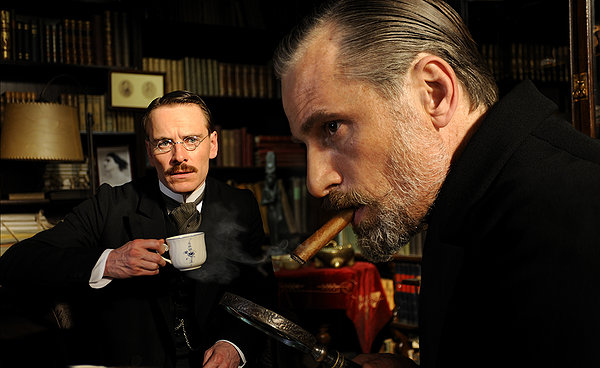A Dangerous Method
Directed by: David Cronenberg
Starring: Michael Fassbender, Keira Knightley, Viggo Mortensen
Rated: R for sexual content and brief language
The birth of psychoanalysis was as painful and difficult as most births seem to be — but it involved several people rather than one surrounded by midwives and caretakers. The fraught relationships between Sigmund Freud, C. G. Jung, and Sabina Spielrein pushed and pulled the science into the complex, widely-differing field we know today. Based on the nonfiction book by John Kerr, “A Dangerous Method” is a dramatization of the early years of psychoanalysis.
When Spielrein (Keira Knightley) is brought screaming and raving to Burghölzli, the psychiatric hospital at the University of Zurich in Switzerland, her case immediately intrigues the young doctor Jung (Michael Fassbender). He successfully treats her with the “talking cure” recently developed by Freud (Viggo Mortensen), and begins a correspondence with Freud that turns into a close mentor relationship. As Spielrein becomes more and more lucid and begins helping Jung with his research, their relationship slides from patient-doctor to friendship to (nearly as unthinkable then as now) romantic. As the years pass, Jung and Spielrein’s relationship adds to the rift already developing between Jung and Freud, who have very different ideas of the direction their budding field should go.
“A Dangerous Method” is a strange and complex film. The actors are all talented, and in the hands of a director as strongly interested in psychology as David Cronenberg, they deliver striking performances. Mortensen is unfortunately not given much to work with by the script, as Freud was already very set in his ways by the time of the film, but the other actors have plenty to sink their teeth into. Knightley’s portrayal of Spielrein’s illness may be considered over the top by some, but I felt it worked well, particularly as the character grows more and more lucid and able to move in society. Knightley handles the gradual shift from bodily contortions and distorted speech to nearly-normal behavior very well.
As the central character of the film, Fassbender has the most to work with. Jung finds himself challenged by another patient at Burghölzli (Vincent Cassell, who is a delight), a fellow psycho-analyst who affects Jung as much as the doctor affects him, if not more so. Fassbender handles Jung’s angst and gradual disillusionment with Freud deftly.
Where the film is lacking is in its pacing and overall flow — there are numerous jumps forward in time, and only some of them have helpful notation of how much time has passed. Worse, there’s almost nothing done visually to show the passage of time, even though the film covers nearly two decades. It’s nearly wall-to-wall talking, with so little done to set the scene between sequences that it’s easy to lose track of where it is in time.
That aside, however, this is a thought-provoking and fascinating film, and a must-see for those interested in art-house cinema or psychology. Those who require shootouts, action, or simplicity in their films will be happier elsewhere.
